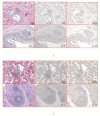Evaluation of the Relationships between Intestinal Regional Lymph Nodes and Immune Responses in Viral Infections in Children
- PMID: 35008744
- PMCID: PMC8745466
- DOI: 10.3390/ijms23010318
Evaluation of the Relationships between Intestinal Regional Lymph Nodes and Immune Responses in Viral Infections in Children
Abstract
Viral infections increase the risk of developing allergies in childhood, and disruption of mucosal homeostasis is presumed to be involved. However, no study has reported a role for viral infections in such disruption. In this study, we clarified the mechanism of immunoglobulin A (IgA) overproduction in viral infections. Autopsies were performed on 33 pediatric cases, IgA and interferon (IFN)β levels were measured, and histopathological and immunohistochemical examinations were conducted. Furthermore, we cultured human cells and measured IFNβ and IgA levels to examine the effect of viral infections on IgA production. Blood IgA levels in viral infections were higher than in bacterial infections. Moreover, IFNβ levels in most viral cases were below the detection limit. Cell culture revealed increased IgA in gastrointestinal lymph nodes, especially in Peyer's patches, due to enhanced IFNβ after viral stimulation. Conversely, respiratory regional lymph nodes showed enhanced IgA with no marked change in IFNβ. Overproduction of IgA, identified as an aberration of the immune system and resulting from excessive viral infection-induced IFNβ was observed in the intestinal regional lymph nodes, particularly in Peyer's patches. Further, increased IgA without elevated IFNβ in the respiratory system suggested the possibility of a different mechanism from the gastrointestinal system.
Keywords: Peyer’s patch; cell culture; child; immune system; immunoglobulin A; interferon β; regional lymph node; viral infection.
Conflict of interest statement
The authors declare no conflict of interest.
Figures







Similar articles
-
Differential effects of vasoactive intestinal peptide, substance P, and somatostatin on immunoglobulin synthesis and proliferations by lymphocytes from Peyer's patches, mesenteric lymph nodes, and spleen.J Immunol. 1986 Jan;136(1):152-6. J Immunol. 1986. PMID: 2415614
-
Alternate mucosal immune system: organized Peyer's patches are not required for IgA responses in the gastrointestinal tract.J Immunol. 2000 May 15;164(10):5184-91. doi: 10.4049/jimmunol.164.10.5184. J Immunol. 2000. PMID: 10799877
-
Elevated membrane IgA+ and CD4+ (T helper) populations in murine Peyer's patch and splenic lymphocytes during dietary administration of the trichothecene vomitoxin (deoxynivalenol).Food Chem Toxicol. 1990 Jun;28(6):409-20. doi: 10.1016/0278-6915(90)90087-4. Food Chem Toxicol. 1990. PMID: 2145206
-
Lymphoid microenvironment in the gut for immunoglobulin A and inflammation.Immunol Rev. 2003 Oct;195:190-201. doi: 10.1034/j.1600-065x.2003.00066.x. Immunol Rev. 2003. PMID: 12969319 Review.
-
The preference for switching to expression of the IgA isotype of antibody exhibited by B lymphocytes in Peyer's patches is likely due to intrinsic properties of their microenvironment.Immunol Res. 1991;10(3-4):393-5. doi: 10.1007/BF02919728. Immunol Res. 1991. PMID: 1955763 Review. No abstract available.
Cited by
-
Secretory IgA modifies the association between early-life gut microbiota trajectories and childhood nonatopic wheeze.ERJ Open Res. 2025 Aug 11;11(4):00240-2025. doi: 10.1183/23120541.00240-2025. eCollection 2025 Jul. ERJ Open Res. 2025. PMID: 40791923 Free PMC article.
-
Construction of a novel lipid drop-mitochondria-associated genetic profile for predicting the survival and prognosis of lung adenocarcinoma.Discov Oncol. 2024 Nov 17;15(1):668. doi: 10.1007/s12672-024-01526-8. Discov Oncol. 2024. PMID: 39551861 Free PMC article.
References
-
- Tantilipikorn P., Auewarakul P. Airway allergy and viral infection. Asian Pac. J. Allergy Immunol. 2011;29:113–119. - PubMed
MeSH terms
Substances
LinkOut - more resources
Full Text Sources
Medical
Miscellaneous

